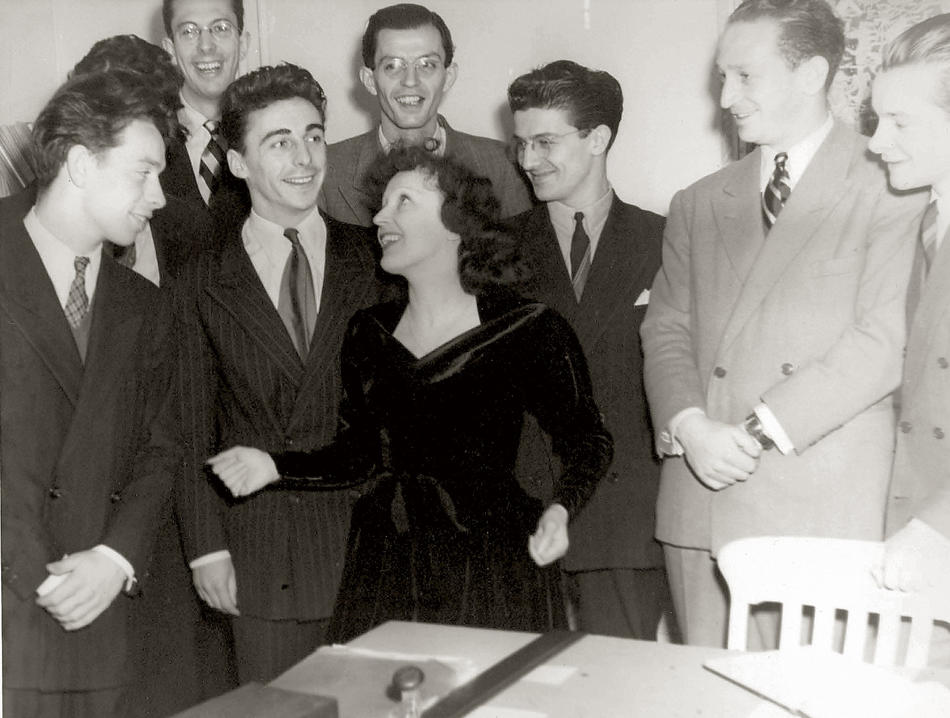I am not a chanteuse réaliste!” insisted Edith Piaf to an interviewer in 1943. It must have seemed like a shocking statement. Over the previous eight years, Piaf had become the foremost interpreter of this uniquely French song genre, filled with sordid stories of thugs, prostitutes, and tragic liaisons. Piaf, though, longed to sing sweeter refrains “that touch the hearts of those who hear them . . . men and women who are pure enough to be moved by love stories.” Not only did she believe that French audiences, especially in the midst of the German occupation, wanted more romantic fare, but it was also what she yearned for herself. For Piaf, the réaliste repertoire was a regular reminder of her sketchy beginnings on the rough Parisian streets.
No Regrets: The Life of Edith Piaf, an engaging, comprehensive new biography by Carolyn Burke ’71GSAS, offers a vivid and revelatory account of the tragedienne’s turbulent life, depicting a fiercely determined, surprisingly reflective woman who strove ceaselessly, though not always successfully, to improve herself and transcend her troubled past.
Abandoned by her mother at three, Edith grew up with her loving but feckless father, Louis Gassion, a transient circus performer, until setting out on her own at 19. Working as a street singer, she was performing “Comme un moineau” (“Like a Sparrow”), a harrowing tale about a prostitute who lives in the gutter, to passersby near the Arc de Triomphe, when she caught the ear of nightclub owner Louis Leplée. Struck by the raw potency of Edith’s untrained voice, Leplée immediately engaged her for his club, and christened her “Piaf,” Paris slang for sparrow.
Aside from her surname, Piaf changed little on her way from street to stage. Waifish and unglamorous, wearing a plain black dress and worn stockings, the diminutive, heavy-lidded chanteuse would stand stock still on the nightclub stage, arms cemented to her side, and let loose a powerful, heart-wrenching vibrato, jolting and then mesmerizing audiences with her confessional-sounding songs about life, love, and loss, tales she understood only too well. Maurice Chevalier, seeing her at Leplée’s club, exclaimed, “That kid sings from the guts.” Piaf was far from the first to embrace the réaliste repertoire; but when the Little Sparrow warbled, these songs became hers.
Numerous biographies of Piaf have been published over the years, many of them playing up the sensational side of her life, notably her countless, tumultuous affairs, which seemed to define her almost as much as did her singing. (In her memoirs, Piaf admitted to having “a desperate, almost morbid, need to be loved.”) Often, the sources for such scandalous information were self-serving and unreliable hangers-on.
In No Regrets, Burke, who earned her PhD in English and comparative literature at Columbia and has written biographies of photographer Lee Miller and poet Mina Loy, tries to go beyond the myth. Avoiding the subjectivity and speculation of some earlier portrayals, Burke maintains a comparatively neutral voice. When she allows herself to break into the narrative, it’s mainly through careful supposition for the sake of plot progression: wondering, where no source material exists, how the singer might have reacted in particular situations, as one might do with a deceased loved one.
Burke doesn’t neglect Piaf’s infamous side, bringing us along to all-night parties and impulsive romances; but she also shows Piaf to be an artist who practiced ceaselessly and worked closely with composers and lyricists, exploring increasingly emotional subtleties in her repertoire. Though this was uncommon for singers at the time, Piaf also began writing her own lyrics, including her popular and defining “La Vie en Rose” from 1946.
Piaf was also exacting with the young singers she mentored — including, most famously, Yves Montand — even as she invariably became romantically involved with them. She worked them hard, coaching them in technique, building a repertoire of new songs from her composer friends, and enabling them to join her at France’s most popular nightclubs.
Burke draws on the singer’s extensive correspondence with Jacques Borgeat — a minor literary figure who met and befriended her at Leplée’s club — recently made available by France’s Bibliothèque nationale. This material also enables Burke to clarify Piaf’s involvement with the Resistance. Though she never cared much for politics, Piaf helped to hide Jewish colleagues during the occupation, sometimes defiantly singing their banned songs, and used her notoriety to aid French prisoners, secretly distributing false identity cards and maps during an 11-stalag tour of Germany.
Piaf was plagued in her final years by addictions to alcohol, painkillers, and other medications that, combined with her force of will, propped her up sufficiently to continue performing through her many illnesses. “If I can’t keep singing,” she told one of her doctors, “I’ll never be able to believe in myself.”
During her final large-scale tour in 1959, Piaf sometimes forgot the lyrics to her songs and often couldn’t complete her set. She finally collapsed near the end of what the press called her “suicide tour.” When she died in 1963 at the age of 47, more than 40,000 mourners accompanied the cortege to Père Lachaise Cemetery, seizing up traffic across the city for the first time since World War II.
Half a century after her death, Piaf remains for Burke “a soul who gave of herself until there was nothing left but her voice and the echo of her laughter.”



